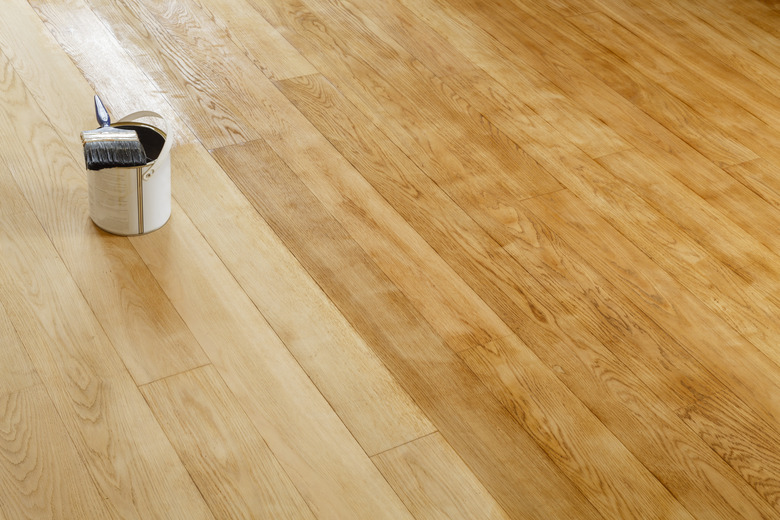How To Resurface Laminate Floors
We may receive a commission on purchases made from links.
Laminate flooring comes with a durable factory finish, and it takes some time for it to wear out, but eventually the inevitable happens and the floor starts to look weather beaten and dull. If the floor were hardwood, this would be the time to refinish it, including sanding off the old finish, but you can't refinish laminate flooring, because it isn't solid wood. The layer under the finish is simply a photographic image of wood, and if you were to sand it, you'd completely remove it and expose the fiberboard core. In short, you'd ruin the floor.
That doesn't mean you're out of options. Instead of refinishing laminate floors, you restore them, and the way to do that is to etch the surface and apply a new finish. Hardwood floor refinishing products will work, and in fact there isn't much difference between them and products you use to resurface a laminate floor. Rust-Oleum Transformations Wood & Laminate Floor Renewal is — as the name says — a product you can use to restore both hardwood and laminate floors.
1. Start By Cleaning the Floor
1. Start By Cleaning the Floor
No new floor finish will adhere to a laminate floor that is greasy, oily or waxy, so all the dirt has to go. Wax in particular will not only prevent the finish from adhering, it will also prevent it from drying, and you'll be left with a sticky goo if you don't remove it.
To clean the floor, mix a cup of vinegar per gallon of warm water, soak a mop in the solution and then — very important — wring out the mop so it's only damp, not wet. You don't want water seeping through the seams in the floorboards and undermining the floor from underneath. Mop the floor in sections, drying each section with a rag before moving on to the next one. The floor shouldn't be waxed — considering that wax isn't recommended by most laminate flooring manufacturers — but if it is, the only way to remove it is to get down on your hands and knees and rub it off with mineral spirits.
2. Degloss and Etch the Finish
2. Degloss and Etch the Finish
There are two ways to get the floor ready for a new finish after you've cleaned it. One is to rent a floor buffer, fit it with a 120-grit sanding screen and run the buffer over the floor. This process is called screening, and it's what professional refinishers do when restoring the finish on a hardwood floor. It's safe to do this on laminate floors because the screen doesn't cut all the way through the finish, so there's no danger of sanding off the decorative coating.
An easier alternative is to use a liquid de-glosser, also known as liquid sandpaper. You'll want to read and follow the instructions for the product you use, but basically, you spread a thin coat of the liquid with a rag or mop, then wait for it to dry. That's usually all there is to it, although some products may need to be wiped off with a damp rag before you apply the finish.
3. Apply a New Polyurethane Finish
3. Apply a New Polyurethane Finish
Products like Rust-Oleum Transformations are basically water-borne polyurethane, which is typically milky white in the bottle but dries to a clear finish. Before applying it, be sure to wipe the floor with a tack cloth to remove any dust, particularly if you screened the floor.
The best tool for applying the product is a floor finish applicator, which looks like a push broom with a wool or foam pad instead of bristles. Pour the finish on the floor in a line next to a wall and draw the applicator through it, keeping the applicator angled to let the excess trail off on the side that still needs finish. Sweep the applicator in a straight line parallel to the floorboards from one wall to the opposite one, moving slowly to avoid making bubbles, and work from one side of the room to the other, pouring more finish as needed.
Tip
Waterborne polyurethane doesn't have much odor, but you'll still want to keep the room ventilated and wear a respirator. Let the first coat dry hard to the touch (about 2 hours) then apply a second coat. Wait 24 to 72 hours for the finish to cure before moving furniture around.
